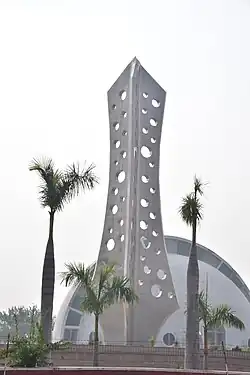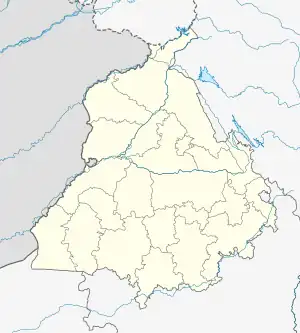Malerkotla | |
|---|---|
City | |
 Kuka Martyrs Memorial, Malerkotla | |
 Malerkotla Location in Punjab, India  Malerkotla Malerkotla (India) | |
| Coordinates: 30°31′00″N 75°53′00″E / 30.5167°N 75.8833°E | |
| Country | India |
| State | Punjab |
| District | Malerkotla |
| Founded by | Dera Ismail Khan |
| Named for | Sardar Maler Kotla Wala |
| Government | |
| • Type | Municipal Council |
| • Body | Municipal Council Malerkotla |
| Area 788 | |
| • City | 122 km2 (47 sq mi) |
| • Urban | 457 km2 (176 sq mi) |
| • Metro | 456 km2 (176 sq mi) |
| • Rank | 12th |
| Population | |
| • City | 135,424 |
| • Rank | 31st |
| • Density | 1,100/km2 (2,900/sq mi) |
| • Urban | 374,000 |
| • Metro | 236,000 |
| Demonym | 433,000 |
| Time zone | UTC+5:30 (IST) |
| PIN | 148023 |
| Vehicle registration | PB-28 |
| Website | www |
Malerkotla is a city and district headquarters of Malerkotla district[1] in the Indian state of Punjab. It was the seat of the eponymous princely state during the British Raj. The state acceded to the union of India in 1947 and was merged with other nearby princely states to create the Patiala and East Punjab States Union (PEPSU).
When that political entity was reorganised in 1956, the territories of the erstwhile state of Malerkotla became part of Punjab.[2]
It is located on the Sangrur-Ludhiana State Highway (no. 11) and lies on the secondary Ludhiana-Delhi railway line. It is about 50 kilometres (31 mi) from Ludhiana and 35 kilometres (22 mi) from Sangrur in Sangrur district.
In 2021, the city along with some adjoining areas were carved out of Sangrur district to form the Malerkotla district.[3]
History
Malerkotla, a Muslim majority state was established in 1454 by Sheikh Sadruddin-i-Jahan from Afghanistan,[4] and was ruled by his Sherwani descendants. The State of Malerkotla was established in 1600 A.D. During the 1947 riots when Punjab was experiencing heavy amounts of communal violence, the State of Malerkotla remained relatively peaceful.[4]
The roots of communal harmony date back to 1705, when Zorawar Singh and Fateh Singh 9 and 7 year old sons of tenth Sikh Guru, Guru Gobind Singh, were ordered to be bricked alive by the governor of Sirhind Wazir Khan. While his close relative, Sher Mohammed Khan, Nawab of Malerkotla, who was present in the court, lodged a vehement protest against this act and said it was against the tenets of the Quran and Islam. Wazir Khan nevertheless had the boys bricked into a section of wall whilst still alive. At this, the Nawab of Malerkotla walked out of the court in protest. Guru Gobind Singh on learning of this approach had blessed the Nawab and the people of Malerkotla that the city will live in the peace and happiness. In recognition of this act, the State of Malerkotla did not suffer significantly during the Partition of India, in which communal violence permeated throughout Punjab.[4]
Under British colonial rule, a Namdhari uprising was suppressed, and the colonial government ordered execution of 65 captured rebels and those thought to be involved with the rebellion. Cowan (the Deputy Commissioner of Ludhiana) and Forsyth (the Commissioner of Ambala) ordered the Namdharis to be executed with cannons, without any trial, on 17 and 18 January 1872.[5]
During the partition of India, there were no riots or bloodshed in any part of Maler Kotla State. The last Nawab Iftikhar Ali Khan of Malerkotla maintained calm and harmony during the turbulent period. He remained in India and died in the year 1982. His tomb is located in Shahi grave yard situated at Sirhandi gate, Maler Kotla. Many also attribute this peace to the presence of the shrine of Baba Haidar Sheikh, the Sufi saint, who founded the town of Malerkotla more than 500 years ago.[6][7]
A part of the ruling family of Sheikh Sadr-ud-Din Sherwani migrated to Pakistan and lived mostly in Model Town, Lahore, Muzzafargarh, Khangarh.[8]
Malerkotla is famous for its vegetables and badge-making industry,[9] besides its poets and monuments.[10]
Demographics
As per provisional data of 2011 census Malerkotla urban agglomeration had a population of 189,424, out of which males were 82,376 and females were 64,048 . The literacy rate was 70.25 per cent.[11]
Malerkotla is the only Muslim-majority city of Punjab.[12]
Education

Urdu is taught alongside Punjabi in Malerkotla schools due to the local Punjabi Muslim majority.
Nawab Sher Mohammad Khan Institute of Advanced Studies in Urdu, Persian and Arabic is part of Punjabi University, Patiala, and is named after one of the founders of Malerkotla State.[14] It provides facilities for higher research in the languages and literature of Urdu and Persian up to PhD level and additionally runs classes for M.A. (Persian), Certificate courses (Urdu, Persian and Arabic), MSc (IT) two years, MSc (IT) lateral entry, PGDCA (one year), CCA (six months) and M.A (psychology).
There are many schools and institutes including Learning Cottage Of Commerce. There are other schools like Sohrab Public Senior Secondary School, Al Falah Public senior secondary School, the town school, Sahibzada Fateh Singh senior secondary public school, Sita grammar school, Sarvhitkari Vidya Mandir, Modern Secular school, DAV public school and many more. Almighty Public School on Almighty School road, Jamalpura, Malerkotla is a co-education, English Medium Sr. Secondary School. This school provide Education about Islam for Muslim students.
Transportation
Rail
Malerkotla is situated on Delhi-Jakhal-Dhuri-Ludhiana Railway line. The nearest railway junctions are Dhuri (18 km [11 mi]) and Ludhiana 45 km [28 mi]).
Air
The nearest airports to Malerkotla are:
- Chandigarh International Airport, Sahibzada Ajit Singh Nagar, Mohali (about 120 km (75 mi) away)
- Sri Guru Ram Dass Jee International Airport, Amritsar (about 250 km (160 mi) away)
- Sahnewal Airport (IATA: LUH, ICAO: VILD), also known as Ludhiana Airport (about 49.8 km (30.9 mi) (66min) away)
Notable residents
- Iftikhar Ali Khan of Malerkotla (Last Nawab of Malerkotla)
- Anas Rashid (Indian television actor)
- Irshad Kamil (Indian lyricist and poet)
- Mohammad Nazim (Indian television actor)
- Razia Sultana (politician) (Indian Politician)
- Saeed Jaffrey (Indian actor)
- Ahmad Ali Khan of Malerkotla (Malerkotla Nawab)
- Channi Singh (Indian musician)
- Zeenat Begum (Pakistani singer)
- Bobby Jindal (American politician, 55th Governor of Louisiana)
- Mohammad Sajid Dhot (Indian footballer)
- Dr. Mohammad Jamil Ur Rahman (politician)
Gallery
 Gurudwara Sahib Haaw Da Naara
Gurudwara Sahib Haaw Da Naara Mubarak Manzil Palace
Mubarak Manzil Palace Qila
Qila Railway station
Railway station Eidgah
Eidgah
References
- ↑ "Malerkotla is Punjab's 23rd district". The Hindu. 14 May 2021. ISSN 0971-751X. Retrieved 14 May 2021.
- ↑ Malerkotla Punjab at www.india9.com.
- ↑ "District Malerkotla, Government of Punjab | Welcome to District Web Portal of Malerkotla | India". Retrieved 15 September 2022.
- 1 2 3 Goyal, Sushil (19 August 2006). "'Malerkotla has Guru's blessings'". The Tribune. Retrieved 24 March 2013.
- ↑ Rebels Against the British Rule (1995). Bhai Nahar Singh & Bhai Kirpal Singh. Atlantic Publishers & Distributors; Page XXI
- ↑ The Legend of Malerkotla: A Tale from the Punjab (2004) Archived 19 October 2007 at the Wayback Machine 48 min, DVD, ISBN 978-0-8026-0761-4.
- ↑ Bigelow, Anna B (2 December 2000). "Malerkotla: A heritage going to seed". The Tribune. Retrieved 24 March 2013.
- ↑ Malerkotla Muslims.. Archived 2 September 2009 at the Wayback Machine The India Express, August 14, 1997.
- ↑ Chhibber, Maneesh (19 August 2006). "Where peace reigns supreme". The Tribune. Retrieved 24 March 2013.
- ↑ Bigelow, Anna B (21 April 2001). "Tales lost to time". The Tribune. Retrieved 24 March 2013.
- ↑ "Urban Agglomerations/Cities having population 1 lakh and above" (PDF). Provisional Population Totals, Census of India 2011. Retrieved 7 July 2012.
- ↑ "Explained: Why is Malerkotla special for Punjab, and Sikhs?". The Indian Express. 22 May 2021. Retrieved 26 April 2022.
- ↑ "Malerkotla City Population Census 2011 - Punjab".
- ↑ "Urdu academy for Malerkotla". The Indian Express. 20 January 1999.
Further reading
- Kinship and the Political Order: The Afghan Sherwani Chiefs of Malerkotla (1454–1947), Contributions to Indian Sociology, Vol. 28, No. 2, 203–241 (1994).
External links